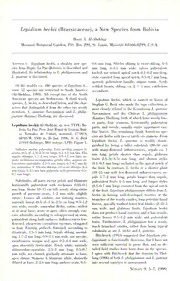
Lepidium beckii (Brassicaceae), a new species from Bolivia PDF
Preview Lepidium beckii (Brassicaceae), a new species from Bolivia
Lepidium beckii (Brassicaceae), a New Species from Bolivia Ihsan A. Al-Shehbaz Missouri Botanical Garden, P.0. Box 299, St. Louis, Missouri 63166-0299, U.S.A. ABSTRACT. Lepidium beckii, a shrubby new spe¬ 0.6 mm long. Silicles oblong to ovate-oblong, 4—5 cies from Depto. La Paz (Bolivia), is described and mm long, 3—3.5 mm wide; valves puberulent, illustrated. Its relationship to L. philippianum and keeled, not veined; apical notch 0.1-0.2 mm deep; L quitense is discussed. style exserted from apical notch, 0.5-0.7 mm long, sparsely puberulent basally; stigma entire. Seeds Of the world’s ca. 180 species of Lepidium L., reddish brown, oblong, ca. 2X1 mm; cotyledons some 52 species are restricted to South America accumbent. (Al-Shehbaz, 1993). All except two of the South American species are herbaceous. A third woody Lepidium beckii, which is named in honor of species, L. beckii, is described below, and the char¬ Stephan G. Beck who made the type collection, is acters that distinguish it from the other two woody most closely related to the Ecuadorian L. quitense members, L. quitense Turczaninow and L. philip¬ Turczaninow and the Chilean L. philippianum pianum (Kuntze) Thellung, are discussed. (Kuntze) Thellung, both of which have woody low¬ er parts, four stamens, horizontally puberulent Lepidium beckii Al-Shehbaz, sp. nov. TYPE: Bo¬ parts, and sessile, usually entire uppermost cau¬ livia. La Paz: Prov. Jose Roma de Loayza, Ban¬ line leaves. The remaining South American spe¬ os Termales de Urmiri, matorral, 17‘’09'S, cies are herbs with two or rarely six stamens. From 68°05'W, 3500 m, 26 Jan. 1996, St. G. Beck Lepidium beckii, L. quitense is readily distin¬ 21944 (holotype, MO; isotype. LPB). Figure 1. guished by being a taller subshrub (20—50 cm) Suffrutex omnino puberulus. Folia sessilia, anguste li- with many-flowered inflorescences, sepals ca. 1 nearia, (0.5—)1—1.5(—2.5) cm longa. 0.5—1.2 mm lata. Flos mm long, petals shorter than sepals, glabrous sepalis oblongis, 1.7—2 mm longis, 0.9—1.1 mm latis, an¬ fruits 2.5—3(—3.5) mm long, and shorter styles guste membranaceo-marginatis; petalis albis, anguste ob- lanceolato-spathulatis, 2.5-3 mm longis, 0.5—0.7 mm la¬ (0.1—0.3 mm long) included in the apical notch of tis; staminibus 4. Silicula oblonga vel ovato-oblonga, 4—5 the fruit. In contrast, L. beckii is a shorter plant mm longa, 3—3.5 mm lata, puberula; stylo persistente 0.5— (10—15 cm) with few-flowered inflorescences, se¬ 0.7 mm longo. pals 1.7—2 mm long, petals longer than sepals, Subshrubs, all parts except petals and filaments puberulent fruits 4—5 mm long, and longer styles horizontally puberulent with trichomes 0.05-0.1 (0.5—0.7 mm long) exserted from the apical notch mm long. Stems 10—15 cm tall, woody along entire of the fruit. Lepidium philippianum differs from L. growth of previous years, 1—2 mm wide, slightly beckii in having well-developed rosettes at the striate. Leaves all cauline, not forming rosettes, branches of the woody caudex, long petiolate basal narrowly linear, (0.5—)1—1.5(—2.5) cm long, 0.5—1.2 leaves, apically toothed lower leaf blades (2—)3—5 mm wide, sessile, somewhat fleshy, entire, widest mm wide, and glabrous fruits. Lepidium beckii at or near base, acute at apex, often strongly con¬ does not produce basal rosettes, and it has sessile, cave adaxially, ascending to subappressed on stem, entire leaves 0.5-1.2 mm wide and puberulent puberulent along both surfaces. Inflorescences few- fruits. Furthermore, L. philippianum has a woody, flowered, ebracteate corymbose racemes, elongated much branched caudex, rather than being typical in fruit. Fruiting pedicels flattened, ascending to subshrubs as are L. beckii and L. quitense. divaricate, 3.5—5 mm long. Sepals oblong, ascend¬ Hitchcock (1945) suggested that Lepidium phi¬ ing, 1.7-2 mm long, 0.9—1.1 mm wide, not saccate, membranous margin and apex 0.2—0.4 mm wide, lippianum is functionally dioecious, but I have not apex obscurely denticulate. Petals white, narrowly seen sufficient material to prove that, and no de¬ oblanceolate-spatulate, 2.5—3 mm long, 0.5—0.7 tailed field studies have been done on the species. mm wide, not clawed, gradually attenuate to base, I agree with Hitchcock that the division by Thel¬ apex obtuse. Stamens 4; filaments white, distinctly lung (1906) of both L. philippianum and L. quitense dilated at base, 2—2.6 mm long; anthers ovate, 0.5— into several varieties is unwarranted. Novon 9: 5-7. 1999. 6 Novon figure I. Ijepidium beckii Al-Shehbaz (holotype). —A. Part of plant. —B. Cauline leaf. —- C. Sepal. —D. Petal. E. Stamen. —F. Fruit and pedicel. Scales A = 1 cm; B = 5 mm; C—F = 1 mm. Volume 9, Number 1 Al-Shehbaz 7 1999 Lepidium beckii from Bolivia Acknoivledgments. I am grateful to Stephan G. Hitchcock, C. L. 1945. The South American species of Lepidium. Liloa 11: 75—134. Beck lor sending his Brassicaceae collections lor Thellung, A. 1906. Die Gattung Lepidium (L.) R. Br. Line my study and to Roy Gereau for correcting the Lat¬ Monographische Studie. Neue Denkschr. Allg. Schweiz. in. Naturf. Ges. 41(1): 1-340. Literature Cited Al-Shehbaz, I. A. 1993. Lepidium tayioriae (Brassica¬ ceae), a new species from Chile. Novon 3: 93—95.
